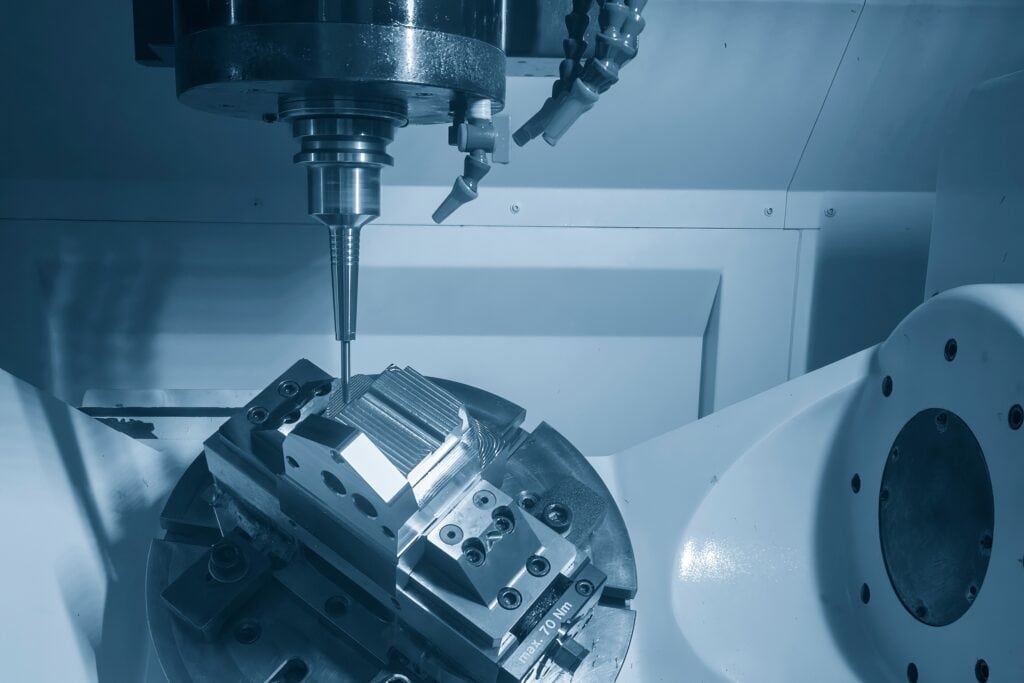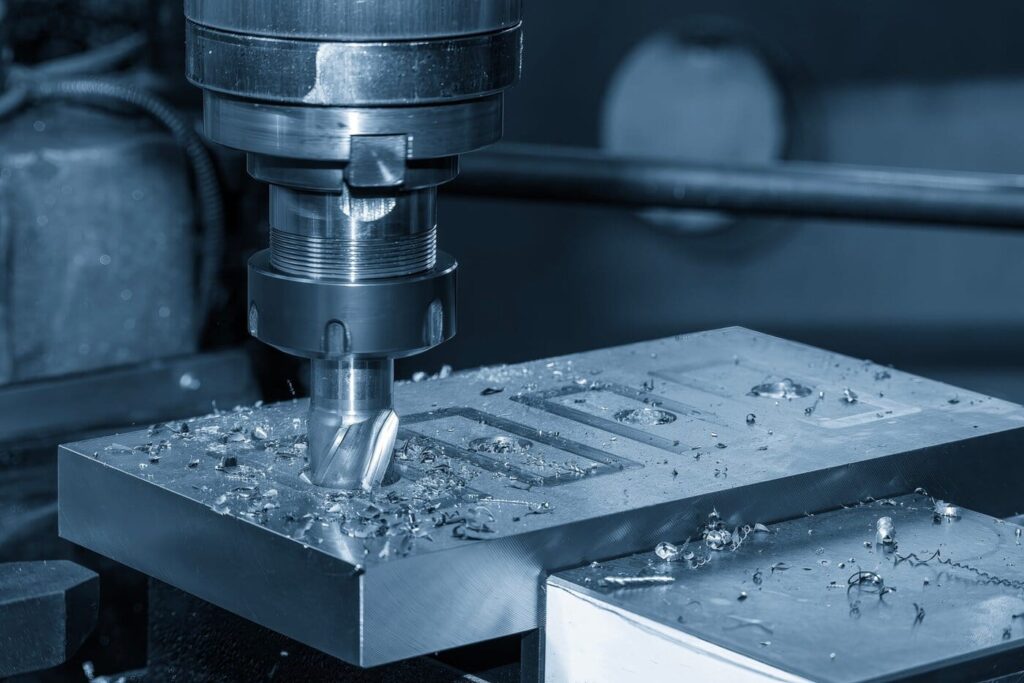It’s so hard to put together a budget for a new part without understanding what goes into CNC machining. As your higher-ups and decision-makers ask you to put together pricing, you might be at a loss — where do you even start?
At Rapid Axis, we’ve been fabricating parts and generating quotes since our first day in business. In this guide, you’ll learn the true costs of CNC machining. We’ll explain what factors can change the cost, how to save money, and how Rapid Axis can be a valuable partner for all of your CNC machining needs.
How Much Does CNC Machining Cost?
CNC machining doesn’t have a single sticker price for every project, it depends on a number of factors that are specific to your project. The complexity of your part, hours required to manufacture, number of units you order, material you’re using, and required tolerancing can dramatically change how expensive a CNC-machined part is.
At Rapid Axis, we’ll put together a per-unit or per-project cost for any project we generate a quote for. Since we have a long history and a lot of experience to pull from, we can put together quotes that will accurately represent the final cost of your parts.
Generally, our per-hour CNC machining costs can range from around $60 to $150+, depending heavily on the precision, machinery, and expertise required.
As a customer, it’s unlikely that you’ll see an exact breakdown of what each specific consideration does to the final cost — to keep it simple, machine shops provide a single quoted price or a price per unit, without a hundred lines of how they got to that number.
Since the complexity of your parts can completely change the final cost, we’re happy to discuss ways that you can streamline and simplify your design to save even more money in our shop.

Factors That Determine CNC Machining Costs
We mentioned that there are tons of factors that ultimately determine the cost of your upcoming CNC machining project. Let’s get a bit more specific.
Number of Units Needed
A major factor that determines CNC machining costs is how many units you’d like us to fabricate. With any CNC machining project, there’s an amount of upfront preparation and programming time. This time involves our machinists getting the CNC machine set up, material loaded into the right position, setting the feed and speed, and programming different cutting operations into the computer.
This setup time is unavoidable, and it can take a while for complicated parts. However, a majority of the setup time is a one-time operation. If we were creating a dozen identical parts, we only need to do the programming once. This translates to a lower per-unit cost for you, and streamlines the project for us.
In addition, we save a lot of money on purchasing when we buy a lot of material.
With these two factors combined, you’ll get huge per-unit savings for larger orders as compared to one-off parts.
Material Choice
Material choice is another huge factor when it comes to the final price, and it’s something that we have very little control over. The simple fact is that some materials cost a lot more than others. Getting a huge piece of exotic material like Inconel or titanium can be orders of magnitude more expensive than a piece of stainless steel or aluminum.
This is why we always tell designers and engineers to use common materials whenever possible.
The material choice also plays into the total turnaround time for your parts. If you want something made out of 6061 aluminum, there’s a good chance we already have the material in stock and it’s way more affordable than a Grade 5 Titanium part that could take a few days or weeks to get to us.
Of course, you’ll need to understand the mechanical limitations of each material (which usually drives the choice during your design), but try to avoid using an exotic material or alloy whenever you can if you want to save money.
Machinery Required
There are a lot of different types of CNC machines that we have on our floor, and they all cost a different amount to run per hour. Things like upfront purchase costs, maintenance costs, and the price of the skilled machinist will determine how much we need to charge to use one machine versus another.
The rule of thumb is that the simplest machine is the least expensive to run, which allows us to charge you a lot less. The difference between running a simple drill press versus a 5-axis machining center is massive.
As an engineer or designer, you have control over which machines will be used to make your part. From our perspective, we’ll always use the simplest machine possible in order to meet your specs and tolerances. A lot of times, that’s a 3-axis CNC milling machine.
If your part requires intricate cuts, has complex faces, or needs pinpoint precision, we will likely need to use a 4-axis or 5-axis machine. This can increase the price a lot.
By simplifying your design, you can lower the overall cost of your parts.
Precision and Part Tolerances
Overall part tolerances are important for any project that requires assembly or has specific fitment needs. In these cases, there’s no avoiding a higher price tag. However, what about a simple project that doesn’t necessarily need tight tolerances? Whenever you can lower your plus or minus tolerances, we can afford to charge you a lot less.
Tighter tolerances require extra precision while machining, more expensive machinery, and higher-cost stock material to make sure we can hit the tolerances.
Naturally, we’ll always fabricate parts that meet your tolerance needs, and we have quality assurance steps to make sure you’re not receiving defective parts. Still, remember that your chosen tolerance can multiply the final cost of your project.
Part Complexity
Simply put, more complicated parts cost more to make. These added complexities require more experienced machinists, better equipment, and more time taken during the manufacturing process. We’re happy to make incredibly intricate parts, but any machine shop would need to charge more since these parts take longer and require more expensive machinists to do the build.
Prototyping vs Production
Making a prototype is completely different from making a production-quality part. This is another unavoidable cost, but worth understanding: prototypes are usually small batch orders that have higher per-unit costs due to the upfront programming and setup we discussed earlier.
Production runs can be in the order of hundreds or thousands of units, which gives us the luxury of charging you a lot less per unit.
With that said, you just need to realize that any quoted price for your prototypes should reduce as you step into full-scale manufacturing. In addition, you can optimize your part during the prototyping phase to make future manufacturing even easier and less expensive.
Finishing Steps Required
Finally, let’s talk about finishing. These are any operations that are done after machining is completed — anything from polishing to painting or sandblasting. Whenever we need to do a finishing step, we also need to charge more for the project.
It goes back to the fact that we need to pay our machinists and staff for every hour they work, and finishing operations take time.
Most of the time, engineering and designing departments can’t do these finishing steps in-house, so it’s another necessary expense for your project. After all, we want you to receive the perfect part that’s ready to go, so we need to do these finishing operations.
How to Reduce CNC Machining Costs
We discussed a lot of different factors that impact your CNC machining costs, but what about ways to save money? We have a few tips that you can do during the design of your parts to save a lot of money during the fabrication of each part:
Pick Common Materials
Picking a common material like 304 stainless steel or 6061 aluminum is a quick way to cut down on your manufacturing costs. More exotic materials cost us more to buy, which means we have to charge you more to cover our costs.
If your part doesn’t specifically need to meet certain mechanical requirements, then it’s always better to opt for a simpler and more readily available material.
Look for Off-The-Shelf Solutions
You’d be surprised how many projects could be done with some simple off-the-shelf parts and minimal machining. Instead of bending and welding an aluminum tube, maybe you can purchase existing square tubing and machine out the features you need.
Instead of creating square framework with bolt holes for a prototype, consider using extruded aluminum like 80/20 channel.
Small considerations like this can expedite your project and save a lot of time. Think of it this way: if swapping to a purchased part saves us 5 hours in the machine shop, then that’s 5 hours we don’t have to charge you for.
Simplify, Simplify, Simplify
We can’t stress this tip enough, especially for beginner designers and engineers: make your parts as simple as humanly possible. Simple parts are easier to make, easier to source, easier to maintain, easier to install, and easier to use.
Not only will a simpler part save you money during manufacturing, but it will likely save you money during the entirety of the part’s lifecycle.
When we see a simpler design, it means that we can use equipment that’s less expensive to run and there is less time taken by setting things up.
Loosen Your Tolerances
Loosening your tolerances is a surefire way to reduce the overall manufacturing costs of your parts. When we get in the world of ±0.005”, there needs to be much more setup, attention to detail, and painstaking alignment during the manufacturing process.
If the exact same part had a tolerance of ±1/4”, we could almost machine it with a blindfold on. The looser your tolerances get, the quicker and more affordable your parts are.
Of course, there are plenty of scenarios where you need tight tolerances and can’t avoid it — in those scenarios, we wouldn’t suggest loosening the tolerance and hurting the functionality of your parts. Instead, just understand where the higher quoted price is coming from.
Use Nominal Sizes Whenever Possible
A machinist loves to see a nominal size on your engineering drawings. To us, it means that we can use standard tooling and quick setups on all of the cuts.
Nominal sizes should be used in:
- Drill sizes. This allows us to use standard cutting tools without added machining complexity.
- Overall sizes. The best scenario is to use overall sizes that match a purchasable piece of stock material. Without needing to machine to piece down to size first, we cut out an entire operation and get the project done quicker and more affordably.
- Thicknesses. Going with a non-nominal part thickness requires us to face-off the entire length of material, which can take a ton of time.
- Bolts and hardware. Every bolt in your design should be a standard size that you can find on McMaster or Grainger. Going with a specialty size and length of hardware could be a costly and time-consuming nightmare to put together.

Optimize Your Parts for Manufacturing
Finally, spend some time optimizing your part for manufacturing. A lot of these tips come from experience, but we’d be happy to hop on a call and talk specifics about your project.
If you have a tapped hole that’s too deep, it could require a secondary machining operation just to make the tap, which could be a massive cost for no gain on your part.
As a general rule of thumb, use standard sizes, eliminate unnecessary features, and simplify as much of your design in order to optimize your part for manufacturing. As you learn more about CNC machining, you will also learn the limitations of these machines which helps you in each design.
Get the Most from Rapid Axis
At Rapid Axis, we’ve been helping companies like yours for decades. We know a ton about CNC machining and we can help manufacture your parts, no matter how complicated or expensive they are. We’re also here to review your designs and help you optimize each part with helpful suggestions to save time and money on each unit.
We’re not afraid of a challenge, but we also want to make sure you never have to overpay for your parts. With our help, you can save time and money on each project.
Conclusion
Knowing the cost of your CNC machining projects is a good way to prepare your budget. We reviewed a number of common factors that play into the overall cost of each part, and we made some suggestions for saving money moving forward. Every project is different, so we can create personalized feedback for your design to save even more money during CNC machining.
In the meantime, reach out to us to get a free quote and better understand the true cost of creating your parts. We’re always here to help, get started with a quote today.

